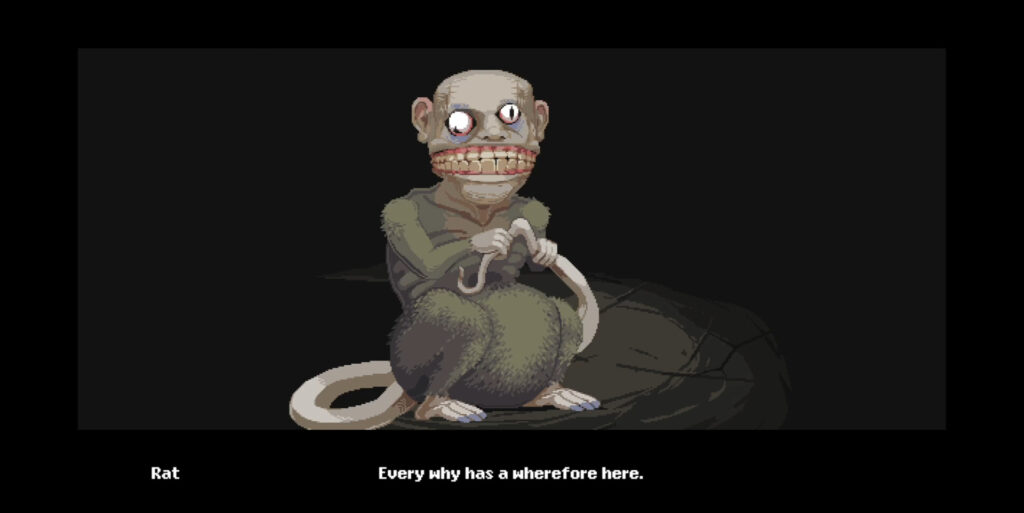Some games want to entertain. Others aim to challenge. Centum wants to make you think—about who you are, how you choose, and what it even means to “play” something. Developed by indie studio Hack the Publisher, this experimental narrative-puzzle game drops players into a digital purgatory where identity, memory, and control blur into one unnerving experience. It doesn’t follow traditional structures, and it doesn’t care if you’re comfortable. That’s the point.
If you’re the kind of player who needs clear objectives and clean endings, Centum might drive you up the wall. But if you’re curious, patient, and open to narrative ambiguity, there’s a quietly powerful experience waiting to unfold.
🧠 What Is Centum?
Centum begins with a simple screen—a flickering terminal, a cold interrogation, and a figure known only as “The Judge” asking if you’re lying. It’s a bleak, jarring start that sets the tone for what’s to come. There are no tutorials, no quest markers, and no exposition dumps. Just you, the world, and the question: Why are you here?
This is a narrative-focused, point-and-click adventure with light puzzle elements. It plays like a strange hybrid of escape room mechanics, interactive fiction, and art-house storytelling. You explore environments, interact with NPCs, solve puzzles, and make choices—but everything is laced with ambiguity. Nothing is clearly explained, and most of your actions feel more symbolic than strategic.
At its best, it feels like a playable short story collection set inside a corrupted operating system. At its most frustrating, it can feel like being asked to solve a riddle with half the clues missing.

🎮 Gameplay: Exploration, Reflection, and Uncertainty
The core gameplay loop revolves around navigating dreamlike rooms and solving abstract puzzles. You’ll:
- Point and click to interact with the environment.
- Collect cryptic items with no immediate purpose.
- Engage in dialogue trees that often shift tone based on your choices.
- Occasionally play arcade-style mini-games or complete reflex-based sequences.
- Jump between visual styles and tones—from sterile tech labs to grimy domestic spaces to surreal digital voids.
Some mechanics feel deliberately clunky—like the lack of item descriptions or the opaque nature of puzzles. But this isn’t lazy design. It’s intentional discomfort. The goal isn’t just to “progress” but to interpret what progress even means.
The gameplay feels minimal in the traditional sense but is layered with thematic depth. As you move through the world, your responses influence how the game behaves—subtly altering dialogue, AI tone, and even which puzzles appear. There’s no morality meter, but it often feels like the game is judging you anyway.
🎭 Themes and Storytelling: Heavy, Ambiguous, and Unsettling
Centum’s story is non-linear and deeply introspective. You aren’t following a single arc—you’re bouncing between personas, timelines, and realities. Some scenes place you in mundane domestic settings, while others resemble a broken computer simulation or an interrogation chamber out of a Kafka novel.
Themes include:
- Identity and memory: Who are you playing? Who were you before?
- Truth and deception: Does honesty even matter in a simulation?
- AI consciousness: What does it mean for an artificial system to reflect on its own actions?
- Digital decay and isolation: You’re alone, but something is always watching.
Conversations are slow, poetic, and often cryptic. There’s a constant feeling that something bigger is happening just outside the frame. Occasionally, the game breaks the fourth wall—not with cheap meta jokes, but with real questions about your intent and participation.
At times, the narrative reaches surprising emotional heights—especially when you uncover threads about family, regret, or lost identity. Other times, it slips into the abstract and leaves you grasping at meaning. Whether that’s compelling or frustrating depends on your tolerance for ambiguity.

🔊 Visuals and Sound: Digital Dread Done Right
Centum isn’t flashy, but it’s effective. The visual design feels like an eerie blend of ‘90s OS aesthetics and analog horror. UI elements glitch, rooms pulse with unnatural lighting, and environments loop in disorienting ways. Each new area feels deliberately alien, designed to unsettle rather than immerse.
The soundtrack leans into ambient minimalism. Low drones, glitchy distortions, and occasional synth melodies underscore the mood. Combined with sparse sound effects and occasional silence, the atmosphere feels oppressive but not overwhelming. It puts you in the right mindset—anxious, unsure, curious.
📱 Platform Support and Accessibility
Available on PC, Nintendo Switch, PlayStation, and Xbox, Centum plays well across all platforms. The touchscreen support on Switch is especially nice for point-and-click interactions.
There are some basic accessibility concerns worth noting:
- No tutorials or clear onboarding.
- Minimal guidance or UI explanations.
- No text size or colorblind options.
- Puzzles are logic-based, but sometimes the logic is internal to the game’s abstract rules.
In short: the game wants you to figure things out alone. That’s part of its philosophy, but not great for players who need more clarity or accessibility tools.
🔄 The Experience: Meditative or Maddening?
Playing Centum feels like stepping into someone else’s dream—or nightmare. It’s slow, subtle, and often disorienting. Some players will love how the game rewards patience, observation, and interpretation. Others will be turned off by its refusal to explain or guide.
Where it stumbles most is in the final act. After a strong opening filled with mystery and layered symbolism, Centum narrows its focus onto specific character stories. These moments can feel underdeveloped compared to the more abstract brilliance that comes before. The ending doesn’t tie up loose ends—it opens more.
And that’s intentional. The goal isn’t resolution. It’s reflection.

✅ Highlights: Where Centum Connects
🧠 Thoughtful Storytelling
Philosophical and psychological themes handled with care. Conversations feel loaded with meaning, not filler.
🌌 Unique Atmosphere
Unnerving environments and glitchy visuals create a distinct and memorable mood.
🔁 Replayable Paths
Your choices influence AI behavior and open subtle narrative variations, encouraging multiple playthroughs.
📱 Platform Versatility
Touchscreen on Switch is a bonus, and the minimalist design runs smoothly across all systems.
🧩 Puzzle-Driven Exploration
While sometimes vague, the puzzles are rewarding for players who enjoy solving through observation and experimentation.
❌ Short Circuits: Where Centum Falls Short
🧳 Lack of Clarity
No item descriptions or objective indicators. This makes discovery feel immersive, but sometimes frustrating.
🚫 Story Pacing Issues
The final chapters lose steam and focus too much on less interesting personal arcs.
🌀 Abstract to a Fault
Some scenes are too vague or symbolic, risking pretension over substance.
🧱 Accessibility Limitations
Minimal settings or support options may alienate some players.
⏳ Short Runtime
At 4–5 hours, the experience is brief. Replay value is present, but it’s still a small-scale game.
Centum: Centum doesn’t want to entertain everyone. It wants to linger. It’s not a puzzle game in the traditional sense, nor is it a narrative game in the way we’ve come to expect. It’s a playable mood, a psychological Rorschach test rendered in pixels and static. You won’t find all the answers. But if you’re the kind of player who’s okay living in the questions, Centum is something rare, strange, and quietly remarkable. – Obsidian


